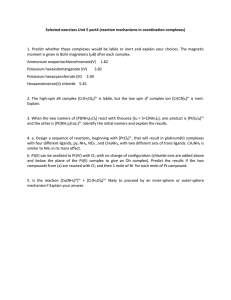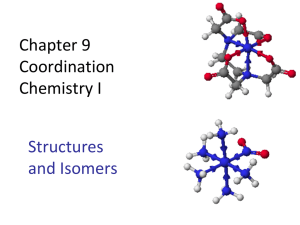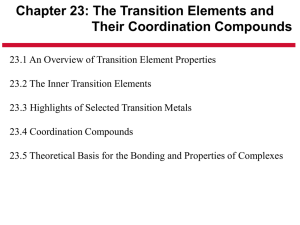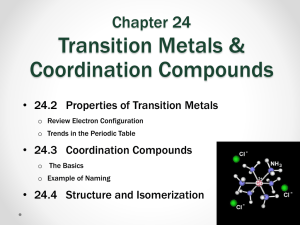Chapter 3 Coordination chemistry
advertisement
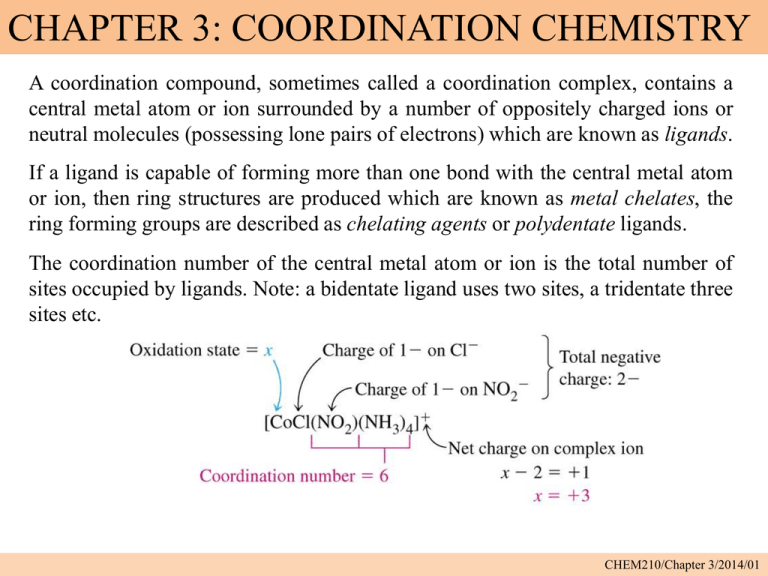
CHAPTER 3: COORDINATION CHEMISTRY A coordination compound, sometimes called a coordination complex, contains a central metal atom or ion surrounded by a number of oppositely charged ions or neutral molecules (possessing lone pairs of electrons) which are known as ligands. If a ligand is capable of forming more than one bond with the central metal atom or ion, then ring structures are produced which are known as metal chelates, the ring forming groups are described as chelating agents or polydentate ligands. The coordination number of the central metal atom or ion is the total number of sites occupied by ligands. Note: a bidentate ligand uses two sites, a tridentate three sites etc. CHEM210/Chapter 3/2014/01 Molecular formula Lewis base/ligand Lewis acid Donor atom Coordination number [Zn(CN)4]2- CN- Zn2+ C 4 [PtCl6]2- Cl- Pt4+ Cl 6 [Ni(NH3)6]2+ NH3 Ni2+ N 6 TYPES OF LIGANDS MONODENTATE When ligands donate one pair of electrons to the metal atom. chloro hydroxo amine methylamine CHEM210/Chapter 3/2014/02 BIDENTATE Ligands that contain two of more atoms, each of which can simultaneously form two-electron donor bonds to the same metal ion. These ligands are also called chelate ligands. ethylenediamine (en) oxalato (ox2-) MULTIDENTATE Diethylenetetramine (trien), EDTA, etc. CHEM210/Chapter 3/2014/03 ISOMERS Ionization isomers Isomers can produce different ions in solution e.g. [PtCl2(NH3)4]Br2 ⇌ [PtBr2(NH3)4]Cl2 Polymerization isomers Loose term, “same stoichiometry, different arrangement in space” Seven compounds with formula Co(NH3)3(NO2)3 Coordination isomers [Co(NH3)6]3+ [Cr(NH3)6]-3 [Co(CN)6]3+ [Cr(CN)6]-3 Linkage isomers e.g. Nitro and nitrito, N or O coordination possible. CHEM210/Chapter 3/2014/04 CHEM210/Chapter 3/2014/05 Geometric isomers Formula is the same but the arrangement in 3-D space is different e.g. square planar molecules give cis- and trans- isomers. For hexacoordinate systems other species, can also occur. CHEM210/Chapter 3/2014/06 CHEM210/Chapter 3/2014/07 For M(X)3(Y)3 systems there is facial and meridian isomers. CHEM210/Chapter 3/2014/08 Are “stereo” isomers also possible? An analogy to organic chirality, molecules which can rotate light. Enantiomers Non-superimposable mirror images. CHEM210/Chapter 3/2014/09 NOMENCLATURE FOR COORDINATION COMPOUNDS Cotton, Wilkinson and Gaus, p 178- 183 CHEM210/Chapter 3/2014/10 CHEM210/Chapter 3/2014/11 CHEM210/Chapter 3/2014/12 CHEM210/Chapter 3/2014/13 CHEM210/Chapter 3/2014/14 CHEM210/Chapter 3/2014/15 CHEM210/Chapter 3/2014/16 CHEM210/Chapter 3/2014/17 CHEM210/Chapter 3/2014/18 CHEM210/Chapter 3/2014/19 CHEM210/Chapter 3/2014/20 THE STABILITY OF COORDINATION COMPOUNDS For a given metal and ligand, complexes where the metal oxidation state is +3 are more stable than +2 Stabilities of complexes of the first row of transition metals vary in reverse of their cationic radii (in general): MnII < FeII < CoII < NiII > CuII > ZnII Chelate Effect A complex containing one or more five- or six- membered chelate rings is more stable, i.e. has a higher formation constant than a complex that is as similar as possible but lacks some or all of the chelate rings. 2+ NH3 Ni2+(aq) + 6 NH3(aq) = NH3 H3N β6 = 108.6 Ni NH3 H3N NH3 (aq) CHEM210/Chapter 3/2014/21 H NH Ni2+(aq) + 3 (en)(aq) = HN H H HN 2+ H NH β6 = 1018.3 Ni NH H NH H (aq) CHEM210/Chapter 3/2014/22
